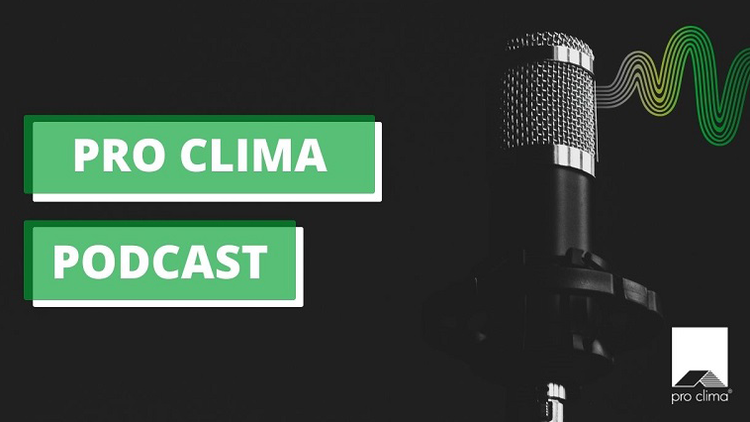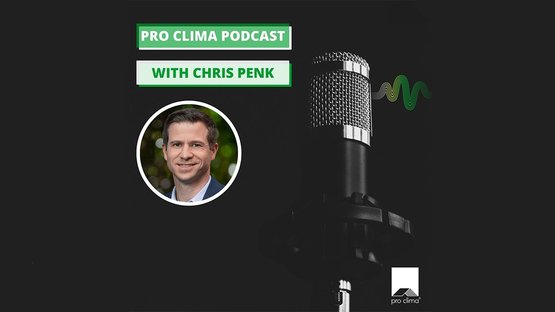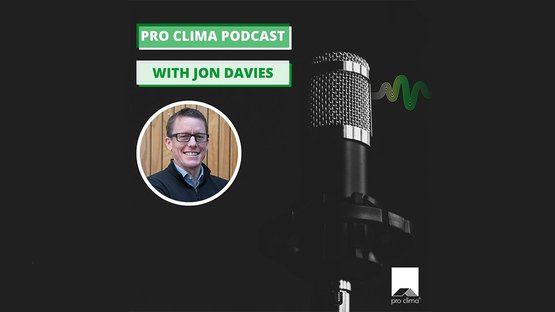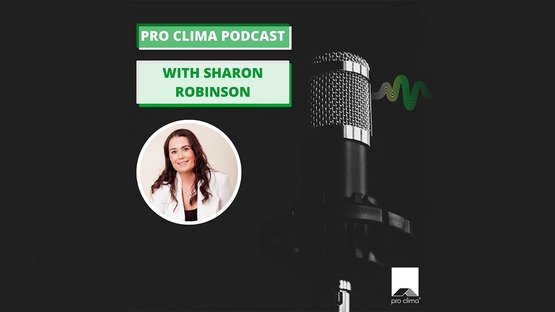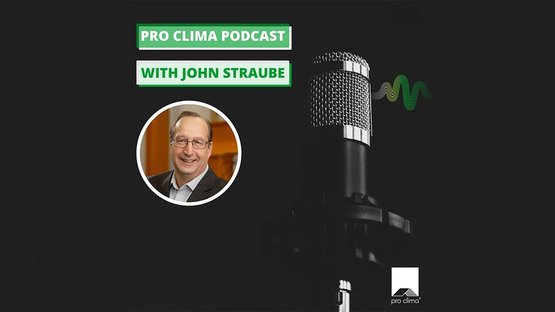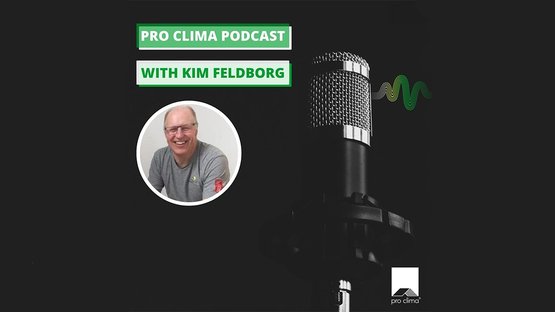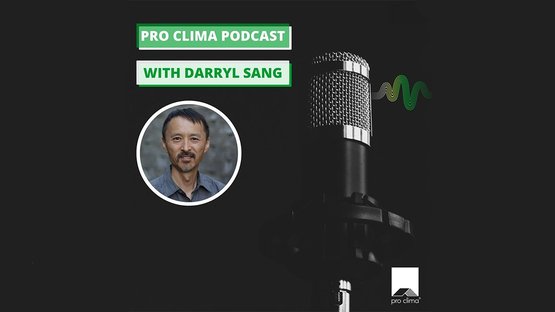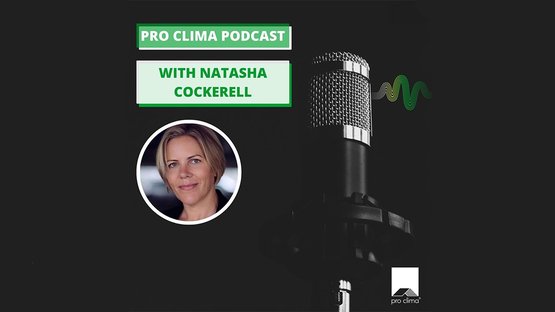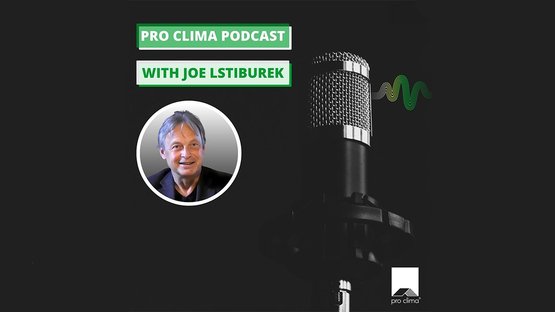pro clima Podcast


pro
clima
Podcast
Welcome to the pro clima Podcast, where we're dedicated to better building practices.
Our mission is to inspire and educate people to create healthy, durable, and energy-efficient buildings to live, learn, work, and play in — now and for generations to come.
In this series, we speak with architects, builders, engineers, and homeowners about what it takes to deliver high-performance buildings. Expect expert insights, practical case studies, and real life stories from those who’ve built and lived it.
We’ll also explore the latest trends and technologies shaping the future of sustainable construction in New Zealand.
Got a topic or question in mind? We’d love to hear from you.
Your podcast host: Simon Cator
The host of pro clima Podcast, Simon Cator, has been in the New Zealand construction industry for 15 years and has experience in ventilation, waterproofing, tanking, and membranes.
He hails from Johannesburg and has worked in the UK and Dubai before calling Auckland his home 16 years ago. In his spare time, he runs a DIY Home Automation YouTube channel called “Simon Says” and has also hosted an 80’s music show on East FM.
Subscribe to the pro clima Podcast on your favourite platform!
pro clima Podcast Episodes
NEWEST to OLDEST
Sharon Robinson Podcast
Bio:
Sharon Robinson is an architectural designer, certified Passive House and Homestar assessor. She started Smart Living Spaces in 2014 so that she should be a part of a positive change in the building industry.
Summary: In this episode, Sharon Robinson, architectural designer, certified Passive House and Homestar designer - shares how her company Smart Living Spaces, is redefining housing accessibility through its innovative Small, Smart Spaces concept. By combining the benefits of group housing, bespoke design, and offsite construction, Sharon is helping make high-performance homes achievable for more New Zealanders. She also explores how Homestar-rated homes can impact energy bills by up to 50% improvement in health and comfort with the same or lower power bills people are used to paying and unlock better mortgage rates, while emphasizing the power of collaboration between designers, builders, and mortgage brokers to deliver affordable, efficient, and healthy homes.
"Stepping up from a code-compliant home, up to Homestar six home, we can halve the power bill. So on one of them, the power bill was roughly about $260 a month for a code compliant version, and that was to keep the home at a healthy constant temperature, between 20 and 25 degrees Celsius, which our building code doesn't guarantee."
Bio: Dr Antony Pelosi is a Senior Lecturer at the Wellington School of Architecture, specialising in sustainable architecture and digital construction. A certified Passive House designer with over 20 years of teaching experience, he integrates robotics, AI, and parametric design to create low-energy, high-performance buildings. His work with leading organisations like Lendlease, BRANZ, and the Ministry of Education reflects his commitment to reducing carbon through innovative, design-led solutions.
Summary: Dr. Anthony Pelosi, a researcher and educator at Victoria University, discusses his journey from building science to architecture, including his time at the University of California, Berkeley. He shares his PhD on spatial comprehension in BIM models and the early use of AI for pathfinding. Pelosi is currently designing a $300,000 passive house, emphasizing cost-effective materials and energy efficiency. He explores AI's role in architecture, highlighting its use in text generation, image rendering, and 3D modeling. Pelosi also discusses the potential of AI in construction, sustainability analysis, and the need for reimagining design and delivery processes to improve efficiency and reduce liabilities.
” I'm going to be really harsh and say the way we design and deliver buildings isn't working very well at the moment. We've got a housing global housing shortage. We've got a quality issue of existing buildings…Something's not right. And I think contractually, there's a lot of opportunity to adjust how we think about these things.”
Episode 29 | Casper Valintin
Guest: Casper is a Dutch national who grew up internationally before settling in New Zealand. With a background in horticulture and IT, he brings a scientific, data-driven approach to high-performance building. Since 2010, he’s been passionate about passive house design, now living in his second high-performance home in Raglan, built using ICF block and a sophisticated ventilation system for comfort and efficiency.
Podcast Topic: In this episode, Casper Valintin shares his journey from a childhood split between Brunei and Scotland to careers in horticulture and IT — and ultimately, to a deep passion for high-performance building. After constructing his first ICF block home in Hamilton, New Zealand, Casper became a strong advocate for Passive House principles. He talks through the features of his own home, including 400mm of roof insulation, continuous slab insulation, and a Zehnder ground-source ventilation system. With sensors tracking performance, he’s fine-tuned the house to maintain a consistent 20°C indoors — proving how smart design, insulation, and ventilation can deliver lasting comfort and efficiency.
It's important to always ventilate. It's key to not just turn the ventilation system off or very low, because that could mean that obviously the building would start heating up a bit more.
Episode 28 | Dr. Allison Bailes
Guest: Allison Bailes is a building science expert with a PhD in physics and a passion for making homes better. After building his own house (with zero construction experience!), he launched Energy Vanguard, a company that blends building science, HVAC design, and education. Allison is also the voice behind the Energy Vanguard Blog and author of A House Needs to Breathe…Or Does It?—sharing practical insights with a mix of expertise and humour.
Podcast topic: In this episode, building scientist Dr. Allison Bailes shares his journey from physics academia to the world of building science. He discusses the importance of airtightness in homes, explaining how it directly impacts indoor air quality, comfort, energy efficiency, and moisture control. Bailes challenges the myth that houses need to “breathe,” advocating instead for air-tight construction combined with well-designed ventilation systems.
When you have an airtight house, you're helping control the moisture as well. You're helping to control the indoor air quality because you're not bringing the pollutants. You're helping to control energy use, durability, and comfort, and also, don't forget that sound travels through air. So when you have an airtight house, you have a quieter house indoors.
Episode 27 | Arena Williams
Guest: Arena Williams is the MP for Manurewa and spokesperson for Building and Construction, Commerce and Consumer Affairs and Youth.
She grew up in South Auckland and has a background as a lawyer, having previously served as a member of the Waitematā District Health Board and on the Unitec Institute of Technology's Te Rūnanga Advisory Group.
Podcast topic: In this episode of the pro clima Podcast, Simon Cator and Jon Davies sit down with Arena Williams, MP for Manurewa, for a conversation on housing, policy, and the future of building in Aotearoa.
They discuss the overseas building products register, unconsented granny flats, and Arena’s vision for her time in parliament. She also highlights the urgent need to modernise New Zealand’s building code—calling out issues like moisture management and fire safety—and the vital role cross-party collaboration and industry input must play in shaping future reforms.
We really need industry professionals who are seeing that kind of thing, those kind of products, these unexpected consequences, to be raising those issues, either with officials or with the politicians who are in charge.
Episode 26 | Sian Taylor
Sian runs Team Green Architects in Queenstown and was one of the first New Zealand architects to become a Passive House Designer. She previously lived in the UK, working in one of the largest firms as a project architect before moving to New Zealand in 2012. She co-founded the New Zealand Architects Declare movement, which encourages architects to unite and declare a climate and biodiversity emergency and is a regular keynote speaker where she shares her expertise in sustainable construction.
Podcast topic: In this episode of the pro clima Podcast, architect Sian Taylor shares her journey from growing up in Wales to designing and living in a Passive House in Queenstown. She reflects on the contrasts between UK and New Zealand building standards, highlighting the superior comfort and energy efficiency of Passive House design.
Sian also critiques the current New Zealand building code, calling out its shortcomings and advocating for stronger regulations, especially the need for mandatory energy modelling to address issues like overheating.
I think the biggest risk now is if we don't start by making it mandatory to energy model buildings, then we do have risks associated with things that are still not within the code or haven't been addressed, things like ventilation. Appropriate ventilation is probably a key one, overheating, something that's been in the news.
Episode 25 | Mark Anderson
Guest: Mark Anderson of MA Building specializes in completing smart energy efficient homes in Wanaka. He grew up around building sites with his father being a builder.
Podcast topic: In this episode of the pro clima Podcast, Simon Cator sits down with Mark Anderson of MA Building, a Wanaka-based builder, as he shares how an apprenticeship alongside his father led to his journey into building high-performance homes, focusing on health and comfort. He reflects on his commitment to energy efficiency and how it drives his focus on Passive House standards and smarter building methods.
He discusses his role in community initiatives like the Better Building Working Group, his plans for a low-energy home, and the small design decisions that make a big impact on comfort, cost, and sustainability.
It was almost better having a house in the 60s than in the 2020s nowadays. And the old builders, they used to say, We don't know why we're putting this foam around the windows; the house needs to breathe. And in your mind, you're like, breathe, yeah, but that's just letting cold air in. Like, that's ridiculous. But they had a point, right?
Episode 24 | Jason Quinn
Guest: Jason Quinn is the founding director of Sustainable Engineering in Wellington. As a Passive House Designer/Certifier and building scientist, his work centres on the intersection of physics and building design. He focuses on applying technical analysis to optimise building performance and address complex design challenges. Jason previously practised as a mechanical and aerospace engineer, most notably at NASA, the US government agency for exploration of space.
Podcast topic: In this episode of the pro clima Podcast, host Simon sits down with Jason Quinn, the Director of Sustainable Engineering, as they discuss overheating in homes and how to design to prevent it from happening.
Jason explains the balance between reducing heat gain in the summer and losing some solar gain in the winter, and the importance of good glass specification.
He also goes over the importance of understanding building performance through modelling and making design changes early in the process to avoid any problems in the future.
The building code in New Zealand could use a lot of improvements. And the science is pretty clear.
Episode 23 | Bronwyn Barry
Guest: Bronwyn Barry is a registered architect based in San Francisco and Principal of Passive House BB. She is a Passive House Designer and founding member of Passive House California (PHCA) and the Passive House Network (PHN).
Podcast topic: In this episode of the pro clima Podcast, host Simon Cator sits down with Bronwyn Barry, Principal at PassiveHouseBB, for an insightful conversation about Passive House design.
Bronwyn discusses a cost-effective prefabricated panel solution that still offers a high insulation value. She also shares her perspective on an often-overlooked advantage of Passive House design: superior acoustic comfort.
Any building can be boring, but a simple building can also be incredibly elegant. And I think what we've forgotten as architects is that detailing and material transitions can hold an incredible world of beauty and a complexity with just how you put things together.
Episode 22 | Denise Martin
Guest: Denise Martin is the director at BEO – Building Envelope Optimisation. She is passionate about building science and has a drive to educate people about all things Passive House and building science. She describes herself as a Passive House geek and Blower Door aficionado.
Podcast topic: Join Simon Cator as he sits down with Denise Martin, Director at BEO, for an insightful discussion on building science and insulation practices in New Zealand. Denise explores the unique challenges of insulating concrete structures and explains the advantages of exterior insulation. She also highlights how proper insulation and airtightness can lead to significant energy savings, ultimately reducing your power bill.
Throughout the conversation, Denise shares expert insights on the relationship between airtightness and energy performance and the crucial role of ventilation and moisture management in creating a healthier home environment.
Tune in for valuable knowledge on building smarter, more efficient homes.
We've done studies in the past, we could actually show that, between a low airtightness to a very high airtightness, there's quite a bit of a gap in terms of your energy performance.
Episode 21 | Graham Finch
Guest: Graham Finch is the Principal Science Specialist at RDH in Vancouver. He holds a bachelor of Applied Science in civil Engineering, and a Master of Applied Science, Building Science Engineering. His graduate work took a deep dive into real world performance of rainscreen walls in Coastal BC and beyond. He has over 25 years of experience in the building enclosure industry experience.
Podcast topic: In this episode of the pro clima Podcast, host Simon Cator sits down with Graham Finch, Principal Science Specialist at RDH Building Science, for an in-depth discussion on rain screen walls—their function, importance, and the key differences between open and closed rain screens.
Graham shares his expert insights on how different cladding systems impact not only the performance of a building but also its longevity, highlighting critical considerations for architects, builders, and designers.Whether you're a construction professional or simply interested in the science behind moisture management in buildings, this episode is packed with valuable knowledge you won’t want to miss!
If you want to use lower embodied carbon materials, whatever they are, you’ve got to watch durability. And that's where we've seen some challenges.
Episode 20 | Dan Saunders
Guest: Dan Saunders is the Company Director at Dan Saunders Construction and has over 31 years’ experience in the industry. He specialises in high-performance buildings and is a Certified Passive House Tradesperson. Dan is passionate about building more healthy, energy efficient homes as well as promoting the introduction of building science in New Zealand Building Apprenticeships.
Podcast topic: Join Simon Cator in conversation with Dan Saunders as they explore New Zealand’s H1 building code changes and discuss how we can promote higher standards. This engaging discussion dives into the challenges and opportunities of creating homes that are not only durable but also better suited for Kiwi lifestyles.
Dan shares expert advice on selecting the right building materials, debunks common myths about constructing high-performance homes, and offers practical steps for achieving better results. Whether you’re a homeowner, builder, or simply interested in the future of housing in New Zealand, this is a conversation you won’t want to miss.
I would change the building code so it's a more holistic thing, so people have no choice but to build better.
Episode 19 | Bob Burnett
Guest: Bob Burnett is an award-winning Architectural Designer based in Christchurch, renowned for his expertise in environmental and energy-efficient design. With over 30 years of experience, Bob has been a pioneer in creating sustainable, high-performance homes.
Ten years after creating New Zealand's first 10 Star rated Homestar homes, Bob has also now led the design for the "Ngā Whare Pārara" project - low carbon & low energy Superhomes for sale, including New Zealand's first Zero Carbon Superhome, in Somerfield, Christchurch.
Podcast topic: Join Simon Cator as he interviews Architectural Designer Bob Burnett to explore the transformative work behind the Christchurch Earthquake rebuild, the origins of the Superhome Movement, and how to select the perfect architect for your dream home.
In this insightful episode, Bob shares the guiding principles of the Superhome Movement, including airtight designs, low-carbon materials, and the importance of responsibly sourced resources. He reflects on how witnessing the Christchurch rebuild and the prevalence of substandard housing across New Zealand inspired his mission to design healthier, more sustainable homes.
If we had a decent building code, we wouldn't need a Superhome Movement. But because the building code is so sub-par, and there's a real lack of innovation, a lack of awareness about the need to do better.
Episode 18 | Nick Gaites
Guest: Nick Gaites is the Director of Reveal Building Consultants. He is a registered building surveyor and Certified Passive House consultant. Originally from the Isle of Man, Nick moved to New Zealand 20 years ago, where he transitioned from building to surveying, focusing on leaky buildings. Nick is passionate about sustainable building practices, "green" buildings, and designing homes that are energy efficient, thermally comfortable, and provide a healthy indoor environment.
Podcast topic: In this episode of the Pro Clima Podcast, host Simon Cator is joined by Nick Gaites from Reveal Building Consultants for an insightful discussion on one of New Zealand’s pressing housing challenges—overheating. Together, they explore how energy modelling, fixed shading, reduced glass areas, and improved insulation can transform building performance and elevate comfort levels.
Nick also shares valuable strategies for retrofitting existing homes to enhance their performance. From starting with energy modelling to assess current conditions to implementing practical solutions, this conversation provides a roadmap for creating healthier, more energy-efficient housing in New Zealand.
We've run the models, and we're finding we're even getting overheating into the winter months because of just the typical designs that we have in New Zealand.
Episode 17 | Matthew Cutler-Welsh
Guest: Matthew is the Business Development Manager for Home Style Green at the New Zealand Green Building Council. He is also a Passive House Institute board member, hosts Home Style Green and co-hosts the Passive House Accelerator Podcast.
Podcast topic: In this episode of the pro clima Podcast, Simon Cator sits down with Matthew Cutler-Welsh from Home Style Green at the Green Building Council. They discuss the role Home Style Green plays in educating and assisting New Zealanders in designing and building more sustainably, as well as addressing carbon targets and reporting requirements.
Throughout the podcast, Matthew shares insights about the assumptions surrounding new builds meeting healthy living standards. He explains the differences between the three methods for calculating energy or insulation values for homes: the modelling, schedule, and calculation methods. He also examines the efficiency of the Building Code and highlights the significant progress still needed in this area.
So there's no point in being energy efficient without having a home that's warm, dry, and also comfortable all year round.
Episode 16 | Manfred Kehrer
Guest: Manfred Kehrer is a Senior Associate at WJE who has been involved in researching, testing, and analysing exterior envelope and concrete systems. Before he joined WJE, he worked for more than 20 years at Fraunhofer IBP Germany, where he was responsible for the development, quality control, and sales of WUFI® products.
Podcast topic: Join Simon Cator and Manfred Kehrer as they discuss Manfred's upbringing in Bavaria, his interest in building science and how he ended up working at the Fraunhofer Institute
They discuss the early development of WUFI® software and how he helped in the early stages of the development process, working alongside Hartwig Künzel. He touches on the differences between WUFI® modelling and the Glaser method and how the Glaser method can often lead to overestimation of moisture issues.
What people don't know is how many times we discovered measurement errors because we figured out that. I mean, at some point we've seen that the measurement and the simulation doesn't work out well.
Episode 15 | Kara Rosemeier
Guest: Kara is the director of the Passive House Academy New Zealand (PHANZ) and holds a PhD in architecture with a focus on building science. Karas expertise is in building science and she is fluent in building physics, policy and economic aspects of energy efficiency. During her career she has taught at various universities in New Zealand and overseas on these matters.
Podcast topic: Join Simon Cator as he sits down with Kara Rosemeier, the Director of the Passive House Academy New Zealand, discussing Kara's early career as a Physiotherapist to then studying Architecture in Germany before moving to New Zealand in 2001.
Kara talks about her emphasis on building science and shares insights on ventilation in New Zealand homes, highlighting that air change rates don’t often correlate with Blower Door tests and that openable windows alone are insufficient for effective ventilation. Throughout the podcast, she shares valuable insights into the contaminants in your home and the importance of having a continuous ventilation system when it comes to minimising the amount of contaminants in your house.
So the main purpose of the system, obviously, is to keep you healthy, and you keep your house well ventilated. But as a side effect, you get huge energy savings, and you get huge gains in comfort.
Episode 14 | Prof. Dr.-Ing. Hartwig M. Künzel
Guest: Prof. Dr.-Ing. Hartwig M. Künzel has been head of department at the Fraunhofer-Institute for Building Physics in Germany since 1994. He is an expert in building physics, specialising in heat and moisture transfer in building materials, envelope assemblies and whole buildings.
Künzel is an ASHRAE Fellow and has been principal reviser of Chapter 25 of the internationally renowned ASHRAE Handbook of Fundamentals. He is also an International Honorary Member of SHASE, the Japanese Society of Heating, Air-Conditioning and Sanitary Engineers.
He teaches “climate-adapted design” and “indoor climate” as an honorary professor at the University of Stuttgart and has been appointed Adjunct Professor at the University of Tasmania (UTAS).
He holds several patents and has published more than 450 scientific articles in international trade journals, conference proceedings and textbooks.
Podcast topic: In this episode of the pro clima Podcast, Simon sits down with Hartwig Künzel, who shares his journey with Fraunhofer—from accompanying his father at the test fields as a child through his studies in chemical engineering to his pivotal role today at the Institute.
Hartwig dives into the critical role of understanding vapour permeability in construction, highlighting the creation and impact of the WUFI® model. He explains both the significance and complexities of working with WUFI®, along with the challenges that can arise in its calculation. Reflecting on earlier methods of hygrothermal modelling, Hartwig discusses their limitations.
Now at the forefront of construction modelling, Hartwig leads efforts in developing and refining tools to measure risks like mould and rot, and is currently advancing in post-processing models to drive even greater accuracy in building science.
Vapour permeability is probably the most important parameter when it comes to hygrothermal simulations. The good thing about that is that is mostly pretty well known.
Episode 13 | Barry Cope
Guest: Barry Cope is the Group Managing Director at ATTMA – Air Tightness and Measurement Association. With a background in engineering, Barry began his career with an apprenticeship at Oxford Instruments before transitioning to air tightness testing. He played a key role in expanding ATTMA’s certification programmes globally and is a recognised expert in building performance, energy efficiency, and air leakage testing.
Barry is also instrumental in developing new testing technologies and promoting airtight construction standards worldwide.
Podcast topic: In this episode of the pro clima Podcast, Barry shares with Simon his journey from studying engineering to transitioning into airtightness testing with ATTMA where he has worked for 10 years.
Simon and Barry discuss the process of Blower Door testing and emphasise the importance of airtightness testing for energy efficiency, citing that homes with improved airtightness can achieve up to 35% energy savings for heating alone.
Barry talks about the future of airtightness testing, and how he predicts there to be a shift in the way we test for airtightness, instead he predicted we would be using ‘actual energy usage’ metrics rather than predictive models for evaluating building performance, leading to higher energy efficiency standards.
Throughout the podcast, he shares valuable insights into the importance of airtightness in buildings and the effects on energy efficiency in your home. He encourages others to consider the growing global importance of energy efficiency and sustainable building practices.
You can make even a 20% reduction in the amount of energy you use. That adds up over 10 years.
Episode 12 | Vlada Acimovic
Guest: Vlada Acimovic of Sustainable Architecture is a certified Passive House designer, architect, and energy efficiency specialist with over 30 years of experience.
Originally from Belgrade, Serbia, he moved to New Zealand in 2016, where he has become a leader in designing high-performance, energy-efficient buildings. His expertise lies in Passive House design, which focuses on sustainable, cost-effective, and energy-efficient construction.
Podcast topic: In this episode of the pro clima Podcast, Simon and Vlada delve into Vlada’s career as a European-trained architect and Certified Passive House Designer. Vlada, now based in Auckland, is passionate about promoting Passive House design in New Zealand.
Vlada has completed multiple certified Passive House projects and many other high-performance building projects throughout NZ.
During the discussion, he shared some of the main challenges he faces, particularly misconceptions around the cost of Passive House design. He highlighted the need to educate clients and consultants on the numerous benefits of Passive House design while addressing common misconceptions, such as the belief that Passive Houses are prohibitively expensive or that windows can't be opened.
Simon and Vlada also touch on the future of Smart Home Technology integration with Passive House design. Vlada sees great potential in using smart controls—like external shutters and roll blinds—to manage solar gains and air temperature, improving both performance and comfort in Passive Houses.
Throughout the podcast, Vlada emphasizes the critical balance between theoretical knowledge and practical application in house design, stressing the importance of education and raising industry standards in construction.
It's easy to explain why Passive House is champion, because we know that it's arguably the highest possible standard in energy efficiency.
Episode 11 | Murray Alcock
Guest: Murray Alcock is a Director of Pivot Projects - Making property development simple and accessible.
He has wide experience in the property industry with over three decades of involvement in construction, development, capital allocation, due diligence management, acquisition of commercial grade property and the delivery of property developments.
Murray’s role within the company is as Project Director. His primary focus is on business development to grow company activity and capability including matching capital to projects.
Podcast topic: This podcast conversation between Simon and Murray explores Murray’s property development and construction career, his experience with building techniques, and his current efforts to improve housing design and energy efficiency in New Zealand.
Murray is committed to building homes that do not introduce long-term problems to the buyers, emphasizing the importance of keeping the right balance between individual elements such as for example mechanical ventilation & airtightness, choice of materials, and maintaining cost efficiency while meeting higher environmental and livability standards.
He aims to improve construction efficiency by standardizing designs, reducing custom elements, and using offsite manufacturing techniques. The focus is on scalable terrace housing projects designed for long-term investors, emphasising reducing waste and streamlining the construction process.
If we continue just building to code, we're actually building problems into houses for people for the future.
Murray says this when talking about what triggered his interest and what his main driver is when it comes to sustainable building.
Now is the time to press play on my next property development!
Episode 10 | Steve Hughes
Guest: Steve Hughes is a Creator of healthy places and beautiful spaces at Build Good Architecture.
Steve is an architectural designer with Passive House training and over twenty-five years’ experience in design and construction. His latest architectural design, a Passive House Premium certified home, is the smallest Passive House Premium in the world and the only fully off-grid Passive House in New Zealand. He designs super houses - homes for New Zealanders that are healthier and more comfortable to live in, won’t grow mould, use minimal energy to heat and cool, and are beautiful, inspiring spaces, built using sustainable and local resources.
Steve and his family moved from Auckland to the Coromandel Peninsula in 2021 to live their dream life: to build a beautiful, off-grid, passive home and live off the land by growing a lush organic garden.
Steven is friendly, detail-oriented, and creative. His outstanding architecture and high-performance building expertise makes him the perfect choice to bring your dream home to life.
We know that the best way to use a heat pump is to leave it on, set the thermostat, and let it do its job. But because a lot of our housing is so leaky, it becomes expensive to do that.
Podcast topic: In this episode of the pro clima Podcast, Steve shares his journey from living in a renovated 1860s villa in Ponsonby, Auckland, to building an off-grid Passive House in Coromandel. He recounts how the villa’s renovation revealed issues with heat retention, leading to high energy costs and discomfort. This experience and a desire to live more sustainably inspired his family's move to Coromandel, where they began with minimal infrastructure, even living in a tent while constructing their new home.
Steve discusses the process of building the new passive home with Simon, emphasizing the importance of energy efficiency through careful design and the challenges of using unconventional building materials. He explains the significance of proper ventilation, airtightness, and thermal performance for a comfortable home environment and provides insights on energy modelling, cost considerations, and meeting Passive House standards. Steve also addresses the broader context of New Zealand’s housing, stressing the need for improved thermal performance and energy efficiency.
Throughout the podcast, he shares valuable lessons from his hands-on experiences and encourages others to consider sustainable building practices in new constructions, smaller dwellings, or retrofitting projects.
More pro clima Episodes
Episode 9 | Joe Lyth
Guest: Joe Lyth is an Associate Registered Architect at Respond Architects, Certified Passive House Designer and Homestar Assessor with expertise in high performance, new build and renovation design in the UK and NZ. Originally from North Yorkshire in the UK, Joe studied and worked in London from early 2007 before making the move to New Zealand in 2016, when he joined Respond Architects.
After watching his family get sick in cold, mouldy, minimum code buildings, his passion grew for building performance and occupant health. He produced his own project Lower Saddle Passive House to ensure his family's health, and show that healthier, lower energy and affordable buildings are possible for everyone in New Zealand, at standard budgets.
Joe is extremely passionate about education, performing lectures for universities, internally for the company and externally for the wider industry. He is a trainer and co-writer of the new Homestar Designer Course for NZGBC, and was the lead author of the Homestar Design Guide - A Practical Guide to Lower Carbon, Healthier Buildings.
An experienced writer, Joe has received awards for his written work and has produced articles and presentations for bodies such as ArchitectureNow, NZIBS journal, Teulo and others. He is a vocal advocate for efficient, healthier buildings in New Zealand.
Podcast topic: In this episode of the pro clima Podcast, Joe shares his personal journey in architecture, from his childhood in an 1890s farmhouse to pursuing a career in architecture and later moving to New Zealand for a better work-life balance. Facing unhealthy rental conditions in New Zealand, Joe and his wife decided to build their own house to ensure a healthier living environment for their family. They prioritized continuous insulation, high-quality windows, and proper ventilation while balancing budget constraints. Despite challenges, including high construction costs and bank valuation issues, Joe creatively managed to design and construct a functional, affordable, and healthy home by making various compromises.
Joe and Simon discuss building code compliance and energy modelling in New Zealand. Joe highlights the limitations of the building code in ensuring thermal performance and comfort, and argues that energy modelling is the only reliable way to assess a building's performance, as it considers all building elements and the specific site and climate. Energy modelling helps ensure building performance outcomes are met, saving money and reducing carbon. Tune in for more.
Episode 8 | Chris Penk
Guest: Hon Chris Penk is the Minister for Building and Construction, Minister for Land Information, Minister for Veterans, Associate Minister of Defence and Associate Minister of Immigration. Chris feels fortunate to be a part of the Christopher Luxon-led coalition government.
Chris was first elected to Parliament in 2017, as successor to Sir John Key in the then-Helensville seat and re-elected in 2020 and 2023.
Chris is a proud representative for the Kaipara Ki Mahurangi electorate, which includes advocating for constituents on various local issues.
After completing his secondary education at Kelston Boys High School, Chris studied at Auckland University, gaining a Bachelor of Arts degree in 1999 and a Bachelor of Laws (Honours) degree in 2009.
He had joined the Royal New Zealand Navy in 2000, which included serving as an officer of the watch on the HMNZS Te Kaha. He also worked at Government House as aide-de-camp to the Governor-General in 2003. Later, Chris joined the Australian Defence Force and fulfilled his dream of serving in submarines, being appointed navigating officer of HMAS Sheean in 2006, and finally was stationed in the Northern Arabian Gulf in late 2007.
Chris returned to New Zealand in 2008 where he completed his legal training. This culminated in his admission to the bar in 2010 and working as staff solicitor in Auckland. In late 2015 he established his own firm, leaving Ong & Penk Lawyers behind in late 2017 to enter Parliament.
Podcast topic: In this episode of the pro clima Podcast, Simon Cator and Jon Davies speak to Building and Construction Minister Chris Penk.
The discussion revolves around the Minister’s desire to build “Simply, Cheaply and Quickly” - the recent controversial media furore regarding the government's signal to roll back the H1 insulation standards and other building and construction-related issues.
The discussion also touches on easing the regulations for granny flats, developing well-qualified construction workers and revising regulations to maintain building standards.
Hon Chris Penk on H1 Rollback and relying more on the modelling method for compliance:
"We want high standards for various reasons such as health and climate implications of that. We don’t want to pay ridiculously for it. We want a nuanced system that takes into account particular environment."
Episode 7 | Jon Davies
Guest: Jon Davies is the Founder of the Parka Wrap research and initiative, focused on retrofitting external insulation onto the existing walls of occupied homes. This research aims to address the common challenges of renovation, such as high costs, significant disruption, complexity, and unpredictable performance, ultimately striving for improvements for both buildings and their inhabitants.
In addition, Jon manages Pro Clima’s educational initiatives throughout Australia and New Zealand. He leverages his hands-on building experience with his expertise in product analysis to effectively identify and highlight areas within building codes and practices that need enhancement.
I hope we'll see a change in the outcome for renovation work which has energy modelling and predicted energy demand for that building - for any building - in play during the design process; and then just put some minimums around that.
Podcast topic: In this podcast, Jon discusses his transition from teaching to the building industry where tangible results were more easily visible. He talks about a home renovation project, emphasizing the importance of creating a comfortable living environment by addressing common issues like drafts and poor insulation. Jon describes his Masters thesis - the use of Parka Wrap - retrofitting insulation onto existing walls - designed to improve airtightness and contribute to a more controlled indoor environment and energy efficiency in buildings.
Jon advocates for continuous improvement and innovation in building practices. By staying updated with the latest technologies and methods, builders can enhance the quality and efficiency of their constructions. This is particularly important for the retrofit challenge, aimed at improving the performance of existing buildings to enhance the health of their occupants.
To further explore the Parka Wrap principles, reach out to Jon via the Linkedin Page.
Episode 6 | Sharon Robinson
Guest: Sharon Robinson is the Architectural Designer and Director at Smart Living Spaces. Architectural Design with People and Planet in Mind.
Sharon is based in Hamilton. She is focused on Healthy, Comfortable Low Energy Homes and is passionate about sustainable and smart Architecture. With over 20 years of experience in Architecture, she is also a Certified Passive House Designer with Passivhaus Institute NZ and a Homestar Designer and Assessor with the New Zealand Green Building Council. Sharon started her business, Smart Living Spaces, in order to create smaller, smarter, sustainable, and stunning spaces.
Ask yourself, what will your house be worth in 2030? A certified Passive House is on the operating levels, energy-wise, of where we're going in 2030. So, do you consider your house an investment? I think we put more consideration into the performance of the cars we buy than we put into the houses we create, and our homes are the largest financial investment we make in our lives.
Podcast topic: In this podcast, Sharon advises homeowners to research the Passive House principles via the Passive House Institute of New Zealand (PHINZ) website, focusing on insulation, airtightness, quality windows, ventilation, and thermal bridging. She emphasizes the importance of discussing energy efficiency and comfort with building professionals early in the design process. Building high-performance homes from the start is more efficient than upgrading conventional homes later, and smaller, better-performing homes can also be more efficient.
Sharon and Simon also discuss misconceptions about building codes, which often lead to minimal standards being mistaken for optimal performance. Energy modelling and data-driven design are essential for achieving true efficiency and comfort, with professional designers offering long-term savings despite higher initial costs.
To explore the topics discussed in the podcast, visit Sharon's resources: Free Architectural Guidetext and the Passive House Guide.
Episode 5 | John Straube
Guest: John Straube, Principal and Senior Building Science Specialist at RDH Building Science Inc. and a professor of building science at the University of Waterloo’s Civil Engineering Department and School of Architecture.
His research focuses on energy-efficient, healthy, durable, and sustainable building designs, utilizing advanced computer simulations, laboratory testing, and full-scale performance monitoring. Dr. Straube has advised major building product manufacturers, government agencies, design professionals, and building owners.
Recognized as an international expert on moisture-related durability issues, he has applied his expertise to a variety of problems, including moldy roofs, failed masonry, leaky EIFS cladding, insulating Mongolian yurts, wet basements, rotting crawlspaces and attics, historically sensitive retrofits, and litigation support for diverse buildings like commercial office towers, manufactured housing, and sustainable strawbale homes.
Dr. Straube explains the importance of the critical elements of the building structure, balancing insulation values with good airtightness levels and high-performance windows:
It's a rule of physics that you need to be able to match those three components of typical houses to get the value out of each one of those components.
Podcast topic: In this episode of the pro clima Podcast, John Straube emphasizes the importance of balancing components such as insulation, airtightness, windows and ventilation in building design to achieve optimal energy efficiency and indoor air quality. He explains that airtightness is often misunderstood but is crucial for maintaining a healthy indoor environment. Dr. Straube also discusses the principles of rainscreen design, considering the cladding, drainage, and water-resistant barriers, all tailored to local climates and building codes.
For further information on Dr. Straube's work and additional resources, visit the RDH Building Science Technical Library website.
Episode 4 | Kim Feldborg
Guest: Kim Feldborg, Builder and Owner of Valhalla Living
Kim Feldborg is a seasoned NZCB-certified builder who completed his apprenticeship in Denmark and has extensive experience not only as a builder but also as a designer, joiner and carpenter across Europe, including Greenland.
Upon arriving in New Zealand in 2007, he was struck by the inefficiency and coldness of the local houses, despite coming from colder European climates. Kim has built homes in Greenland, Norway, Germany, and England. In 2007, he founded Valhalla Living Ltd in Taupo. His company specializes in energy-efficient and Passive House construction, as well as renovations.
We moved into a brand new house in Taupo, it was double-glazed and looked good, but it was blimmin' cold. I couldn’t understand why people would put up with it. Because of this environment, we decided we wanted to live in a more comfortable house.
Podcast topic: In this episode of the pro clima Podcast, Simon Cator interviews Kim Feldborg, a builder from Denmark who moved to New Zealand in 2007. Shocked by the cold temperatures in his rental home, Kim decided to design and build a Passive House, which he and his family have been living in for over ten years now. Kim explains the differences in home heating between Denmark and NZ, noting that Danish homes typically have central heating systems, whereas Kiwi homes often lack adequate heating. He shares his journey in designing his own Passive House, including sourcing materials and ensuring airtightness. Kim highlights the energy efficiency of the house, which maintains a constant temperature with minimal heating costs. He also addresses common misconceptions about airtight homes, emphasizes the benefits of ventilation systems and discusses the new H1 compliance.
Episode 3 | Darryl Sang
Guest: Darryl Sang, Director of Sang Architects
ANZIA B Arch B Eng - Darryl is a Registered Architect who has been practising for nearly 30 years in London and New Zealand. Darryl brings a unique set of skills to each project; he is also a qualified engineer and a Certified Passive House (Passivhaus) Designer.
He is a highly experienced Director and Team Leader with extensive experience in the delivery of design, organisational and technical delivery of projects including commercial and residential developments.
The Modelling approach is the most accurate way of examining a building. The overall performance needs to be modelled.
Podcast topic: In this episode of pro clima podcast, Darryl shares insights from his experience with energy-efficient building projects, including the Piha EnerPHit renovation and the Legacy House. He talks about the importance of improving the performance of existing homes in New Zealand and proposing standardized systems to facilitate retrofitting. Darryl highlights the challenges of addressing issues like condensation, moisture management, and airtightness in the Building Code. He emphasizes the need for a holistic approach to building design, advocating for increased industry skills and the adoption of modelling approaches to ensure the overall performance of buildings meets high standards and comfort.
Episode 2 | Natasha Cockerell
Guest: Natasha Cockerell, Director of the Respond Architects.
An architect with talent and focus, Natasha is a rarity within the industry – an ‘all-rounder’ combining a capability for sensitive design with an advanced knowledge of building science and technical detailing.
Natasha believes that communication is the key to a successful project and prides herself on building relationships with clients, stakeholders, consultants and contractors to ensure great outcomes.
She is involved in a variety of residential, commercial and educational projects, and although she relishes the challenge of large, complex projects (such as the Takapuna Main Block Development project which is currently under construction), she also appreciates the chance to work with Schools on a variety of unique projects of varying sizes. Natasha is passionate about creating great spaces for learning, and her track record of over 11 years working on Ministry of Education projects reflects this. She's also a member of MoE's Weathertightness Review Panel and the Passive House Institute NZ (PHINZ) Board.
We accept a lot just because we don’t know any different.
Podcast topic: In the second episode of pro clima podcast, Natasha explains how seeing her relatives work in construction sparked her interest in architecture, which she sees as a combination of art and science. From her experiences with leaky buildings to addressing challenges in the industry, we discuss the current state of the New Zealand construction sector, focusing on economic difficulties and the urgent need to address carbon emissions. Looking ahead, she advocates for a shift towards sustainable, energy-efficient building practices, emphasizing holistic approaches to building performance and the importance of homeowner awareness in selecting architects. Natasha champions prioritizing simplicity, efficiency, and comfort in building design, highlighting the potential of energy modelling to deliver better outcomes while saving costs.
Episode 1 | Joseph Lstiburek
Guest: Joseph Lstiburek, Principal of Building Science Corporation
Joe Lstiburek, B.A.Sc., M.Eng., Ph.D., P.Eng., is the founding principal of Building Science Corporation and an ASHRAE Fellow. He is a building scientist who investigates building failures. Dr. Lstiburek received an undergraduate degree in Mechanical Engineering from the University of Toronto, a master’s degree in Civil Engineering from the University of Toronto and a doctorate in Building Science Engineering from the University of Toronto. He has been a licensed Professional Engineer since 1982.
The Wall Street Journal referred to him as “the dean of North American building science.” Fast Company magazine called him “the Sherlock Holmes of construction”. He is internationally recognized and his work has influenced building codes and standards in every climate zone.
Dr. Lstiburek is an acclaimed educator who has taught thousands of professionals over the past four decades and has written countless papers. He has a joy for telling tall tales to his proteges and audiences.
It's not a rocket science, it's a building science!
Podcast topic: In the first episode of the pro clima podcast, we're talking to Joe Lstiburek, the Godfather of Building Science. He delves into his journey from designer to advocate for improved building practices, emphasizing the importance of learning from past mistakes, like weathertightness issues seen in the US or Canada. He reckons the New Zealand construction industry should learn from these mistakes, not keep repeating them. Joe also discusses ventilation concerns and the role of dehumidifiers, suggesting a balanced approach to efficiency. Additionally, he talks about upcoming advancements in design and materials. He stresses the need for education to prevent similar problems from arising in the future.
If you're a building scientist keen to learn more from Joe, head to the resources available on the Building Science Corporation website.

